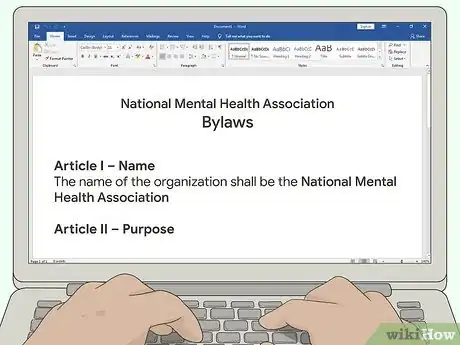This article was co-authored by wikiHow staff writer, Jennifer Mueller, JD. Jennifer Mueller is a wikiHow Content Creator. She specializes in reviewing, fact-checking, and evaluating wikiHow's content to ensure thoroughness and accuracy. Jennifer holds a JD from Indiana University Maurer School of Law in 2006.
There are 8 references cited in this article, which can be found at the bottom of the page.
This article has been viewed 32,285 times.
Learn more...
Nonprofit organizations provide goods and services that benefit a particular group of people or the community in general. If you want to start a nonprofit organization in Canada, get a board of directors together to plan your operations and plan your fundraising and activities. Once you're ready to open your doors, incorporate your organization at either the federal or provincial level. Then you can register with Revenue Canada for tax-exempt status so you can issue income tax receipts to your donors.[1]
Steps
Establishing Your Organization
-
1Determine what goods or services you want to offer. Take a look at the community or group of people you want to serve and figure out how your nonprofit could best benefit them. You'll want to look at the kinds of needs there are and the best ways to help fulfill those needs.[2]
- Look at other nonprofits in your area and what they are doing to figure out unmet needs you can tap into with your organization.
- If you already have a goal in mind, figure out how you're going to provide your goods or services to the people and what kind of resources you'll need to accomplish that.
- For example, if you want to ensure people have access to clean water, you might hand out water filters to people who need them or teach courses in basic water filtration methods.
-
2Draft a mission statement for your organization. Your mission statement outlines your organization's charitable purpose for donors as well as the general public. While it doesn't necessarily have to be lengthy, provide enough detail to keep it from being vague.[3]
- For example, if you wanted to provide greater access to clean water, you might draft a mission statement that describes your goal to ensure that all families in your province have adequate filtration services and the knowledge of how to clean their own water safely.
- Your mission statement may be anywhere from half a page long to a couple of pages long, depending on the focus of your organization and what you want to accomplish. However, typically, you'll want to keep it to a page or less.
- When you choose your board, share the mission statement with them. They may suggest revisions or additions.
Advertisement -
3Create a plan to put your mission statement in action. A nonprofit business plan describes in detail how your organization is going to fulfill its mission and where its resources are going to come from. You'll also outline the organizational structure of your organization.[4]
- Your structure and internal hierarchy largely depend on how you plan to operate your organization. For example, if you plan to recruit a lot of volunteers to work in the community, you would want someone in charge of recruiting volunteers and planning volunteer events.
- Be specific about the services or goods you're going to offer to people and how much they're going to cost, as well as how much it's going to cost to operate the nonprofit. For example, if you're going to offer water filtration devices to families without clean water, you would need an estimate of how much each device would cost your organization to purchase and install.
- Come up with ideas to raise funds for the nonprofit, including fundraising events or social media campaigns, along with realistic projections of how much money these activities will bring in.
- While your business plan doesn't have to be extremely long and detailed at the outset, you'll eventually need a more detailed business plan if you want to seek institutional investment or sponsorship from established nonprofit organizations.
Tip: Search online for free nonprofit business plan templates that will help you draft a comprehensive plan for your organization.
-
4Choose board members for your organization. Choose your board members based on your goals for your organization as well as your organization's purpose. While it's fine to have friends and colleagues on the board, it's also typically a good idea to get an attorney and some sort of financial expert, such as an accountant.[5]
- For example, if you wanted to start a nonprofit to expand access to clean water, you might want to ask a scientist or water expert to be on your board.
- Typically, you want to look for people who share your passion for your nonprofit's cause. However, keep in mind that you also need some general operational expertise, especially if you've never run a nonprofit before.
Tip: Once you have your board in place, have an informal meeting to go over your mission statement, business plan, and any other documents or information you've gathered so far. It's important to get the board in agreement on the organization's purpose and plan.
-
5Look into fiscal sponsorship. If you don't have sufficient resources to get your nonprofit off the ground, you might consider sponsorship from an established nonprofit organization. You may also be able to get sponsorship from educational institutions or for-profit businesses that are aligned with your cause.[6]
- You may also be able to find a nonprofit incubator in your community. Nonprofit incubators act like incubators for business startups to provide you with the resources and connections you need to get your nonprofit off the ground.
- The Tides Canada Initiatives Society has a program that offers fiscal sponsorship to nonprofits. The North Star Fund also maintains a working list of organizations that offer fiscal sponsorships on its website.
- If you don't have a sponsor or other arrangement, you and your other board members can expect to be extremely active in the coming weeks or months to try to raise money at a grassroots level to get your organization off the ground.
Incorporating Your Organization
-
1Choose a corporate name for your nonprofit. Your corporate name can be either a numbered name or a word name. If you choose a numbered name, a number is assigned to your organization when you incorporate. A word name, on the other hand, must be unique to your organization. To get a word name, you must order a Nuans corporate name search.[7]
- To order your name search report, go to https://www.ic.gc.ca/eic/site/075.nsf/eng/home. You can order a federal report or one specific to an individual province or territory. You do not need a Nuans report to incorporate your organization in British Columbia, Quebec, Newfoundland and Labrador, or Nunavut. However, it's typically better to go ahead and get one anyway.
- A Nuans report certifying that your name is unique is not the same thing as a trademark. If you trademark your organization's corporate name, you'll have added protection against other organizations using a name similar to yours.
- Your corporate name can be either English, French, a combined English and French name, or two separate English and French names. However, your name must be unique in both languages.
Tip: Check available URLs and social media accounts to make sure you can establish an internet presence with the name you've chosen.
-
2Decide whether you want to incorporate provincially or federally. As a Canadian nonprofit, you have the option of incorporating either at the federal level or at the provincial level. If you incorporate at the federal level, your organization can operate throughout Canada. If you only plan on operating locally, on the other hand, it may be better for your organization to incorporate in the province or territory where your headquarters is located. Your operations will be restricted to that province or territory.[8]
- Visit the website of your province or territory's corporate registrar for more information about incorporating there. A list of these websites is available at https://www.ic.gc.ca/eic/site/cd-dgc.nsf/eng/cs04578.html.
Tip: Depending on your activities, you may be required to register with your province or territory even if you incorporate federally.
-
3Draft your Articles of Incorporation. The Articles of Incorporation is a document that lists the name and address of your organization, the names and addresses of your board members, and other information about the establishment of your organization. If you're planning on incorporating federally, download the form from the Corporations Canada website. The website of each province or territory's corporate registrar has province-specific forms.[9]
- You aren't required to use the form. You can draft your own articles if you want, or have an attorney draft them for you. However, it's typically easier to use the free form.
Tip: Your Articles of Incorporation can be in English, in French, a mixture of English and French, or a fully bilingual format that uses both languages equally.
-
4Incorporate provincially if you intend to remain local. Visit the website of your province or territory to determine what documents are required to incorporate there. Typically, there will be forms you can fill out. Submit these forms along with any other required documents to incorporate your organization.[10]
- You'll also have to pay an incorporation fee, which varies among provinces and territories. You may pay anywhere from $40 in Nova Scotia to $245 in Yukon Territory, as of 2019. However, this is still typically less expensive than federal incorporation.
- Typically, you'll get a certificate of incorporation within 30 days, although the turnaround time varies among provinces and territories. In Ontario, for example, it may take as long as 60 days, while in Alberta you can get your certificate in as little as 10 days.
-
5Create a federal corporation if you plan to operate in several provinces. To create a federal corporation, go to the Corporations Canada website and click on the "Incorporate" button. Before you get started, make sure you have digital copies of the following:[11]
- Form 4001 — Articles of Incorporation
- Form 4002 — Initial Registered Office Address and First Board of Directors
- A Nuans name search report
Tip: You may also be required to register in the province or territory where your headquarters is located. You'll have to pay a registration fee as well. This fee varies among provinces and territories, but is typically a few hundred dollars.
-
6Draft and file by-laws. Once you're incorporated, you'll have the first official meeting of your board of directors. At this board meeting, you'll draft the by-laws for your organization. These by-laws must be filed with the corporate registrar within 12 months after they've been confirmed by your board of directors.[12]
- Typically, you can just use the model by-laws available on the Corporations Canada website. Make sure you remove any clauses that aren't applicable to your organization.
- If you'd rather create your own custom by-laws for your organization, you might want to try the By-law Builder developed by Corporations Canada and available at https://www.ic.gc.ca/eic/site/cd-dgc.nsf/frm-eng/NGRR-8AFNVX.
Registering Your Nonprofit
-
1Gather documents to complete your registration. Your registration application with the Canada Revenue Agency (CRA) requires supporting documents. While you can apply to register your nonprofit online, you'll need to have these documents scanned and ready to upload. You'll also need your business number (BN) to begin your application.
- Your BN is a unique 9-digit identifier followed by a 2-letter program identifier and a 4-digit reference number. The program identifier will be "RR" for "registered charity," although your registration will be listed as "pending." You can find this number on your certificate of incorporation.[13]
- Documents you'll likely need include all formation documents related to your incorporation, financial records and documents for the organization, documentation of your organization's income and expenses, and other documents and information related to your expected activities.
-
2Access your organization's CRA account. Go to the Canada Revenue Agency website and select "My Business Account." You can register for a new account for your organization using the BN.[14]
- Once you've set up your account, click the link that says "Apply to be a registered charity or RCAAA." This will take you to the online form.
-
3Complete the online form to register your nonprofit as a charity. To start the form, you'll be asked a series of yes or no questions. Your answers to these questions determine what other information you'll be asked to provide. You can save and go back to your application at any time after you start it.[15]
- Check the "progress and status of your application" page to see how far along you are on each section of the application. You can go back and change the information you provided in any section at any time before you submit it.
- When you've completed your application, you'll be prompted to upload digital copies of all required documents.
Tip: View and print a summary of your application for your organization's records after you submit it.
-
4Track the status of your application through your CRA account. Provided your application is complete, you'll receive an acknowledgment letter from CRA. The letter will include the estimated time before your application will be assigned to an officer for review. Once your application is assigned, you can follow its progress through your CRA account.[16]
- If the CRA requires more information or documentation to process your application, you'll get a letter in the mail. Although you have 60 days to respond to this letter, get the requested information to the CRA as quickly as possible to avoid any further delays.
-
5Wait for your notice of registration. The CRA will send you a notice of registration when your registration is approved. This registration includes your organization's registration number and the effective date of registration. Keep the notice of registration in your organization's records along with your incorporation documents.[17]
- If your registration is denied, you'll get a letter stating the reason. You can appeal by sending written notice within 90 days to Assistant Commissioner, Appeals Branch, 250 Albert Street, Ottawa ON K1A0L5.
References
- ↑ https://www.ontariobusinesscentral.ca/blog/how-to-start-a-nonprofit-organization/
- ↑ https://www.ontariobusinesscentral.ca/blog/how-to-start-a-nonprofit-organization/
- ↑ https://managementhelp.org/startingorganizations/start-nonprofit.htm
- ↑ https://www.ontariobusinesscentral.ca/blog/how-to-start-a-nonprofit-organization/
- ↑ https://managementhelp.org/startingorganizations/start-nonprofit.htm
- ↑ https://managementhelp.org/startingorganizations/start-nonprofit.htm
- ↑ https://www.ic.gc.ca/eic/site/cd-dgc.nsf/eng/h_cs03922.html
- ↑ https://www.corporationcentre.ca/docen/home/faq.asp?id=incnp
- ↑ https://www.ic.gc.ca/eic/site/cd-dgc.nsf/eng/cs04970.html
- ↑ https://www.corporationcentre.ca/docen/home/faq.asp?id=incnp
- ↑ https://www.corporationcentre.ca/docen/home/faq.asp?id=incnp
- ↑ https://www.ic.gc.ca/eic/site/cd-dgc.nsf/eng/cs04970.html
- ↑ https://www.canada.ca/en/revenue-agency/services/tax/businesses/topics/registering-your-business/you-need-a-business-number-a-program-account.html
- ↑ https://www.canada.ca/en/revenue-agency/services/charities-giving/charities/registering-charitable-qualified-donee-status/apply-become-registered-charity/apply/submit-application.html
- ↑ https://www.canada.ca/en/revenue-agency/services/charities-giving/charities/registering-charitable-qualified-donee-status/apply-become-registered-charity/apply/submit-application.html
- ↑ https://www.canada.ca/en/revenue-agency/services/charities-giving/charities/registering-charitable-qualified-donee-status/apply-become-registered-charity/application-review-process.html
- ↑ https://www.canada.ca/en/revenue-agency/services/charities-giving/charities/registering-charitable-qualified-donee-status/apply-become-registered-charity/application-review-process.html
















(3)-Status-of-a-Nonprofit-Step-13-Version-2.webp)






(3)-Nonprofit-Organization-Step-19-Version-2.webp)





-Step-3-Version-3.webp)







(3)-Status-of-a-Nonprofit-Step-13-Version-2.webp)





































